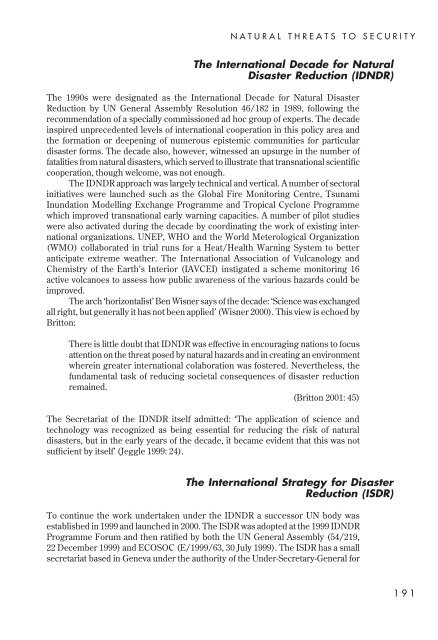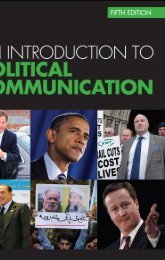Understanding global security - Peter Hough
Understanding global security - Peter Hough
Understanding global security - Peter Hough
You also want an ePaper? Increase the reach of your titles
YUMPU automatically turns print PDFs into web optimized ePapers that Google loves.
NATURAL THREATS TO SECURITY<br />
The International Decade for Natural<br />
Disaster Reduction (IDNDR)<br />
The 1990s were designated as the International Decade for Natural Disaster<br />
Reduction by UN General Assembly Resolution 46/182 in 1989, following the<br />
recommendation of a specially commissioned ad hoc group of experts. The decade<br />
inspired unprecedented levels of international cooperation in this policy area and<br />
the formation or deepening of numerous epistemic communities for particular<br />
disaster forms. The decade also, however, witnessed an upsurge in the number of<br />
fatalities from natural disasters, which served to illustrate that transnational scientific<br />
cooperation, though welcome, was not enough.<br />
The IDNDR approach was largely technical and vertical. A number of sectoral<br />
initiatives were launched such as the Global Fire Monitoring Centre, Tsunami<br />
Inundation Modelling Exchange Programme and Tropical Cyclone Programme<br />
which improved transnational early warning capacities. A number of pilot studies<br />
were also activated during the decade by coordinating the work of existing international<br />
organizations. UNEP, WHO and the World Meterological Organization<br />
(WMO) collaborated in trial runs for a Heat/Health Warning System to better<br />
anticipate extreme weather. The International Association of Vulcanology and<br />
Chemistry of the Earth’s Interior (IAVCEI) instigated a scheme monitoring 16<br />
active volcanoes to assess how public awareness of the various hazards could be<br />
improved.<br />
The arch ‘horizontalist’ Ben Wisner says of the decade: ‘Science was exchanged<br />
all right, but generally it has not been applied’ (Wisner 2000). This view is echoed by<br />
Britton:<br />
There is little doubt that IDNDR was effective in encouraging nations to focus<br />
attention on the threat posed by natural hazards and in creating an environment<br />
wherein greater international colaboration was fostered. Nevertheless, the<br />
fundamental task of reducing societal consequences of disaster reduction<br />
remained.<br />
(Britton 2001: 45)<br />
The Secretariat of the IDNDR itself admitted: ‘The application of science and<br />
technology was recognized as being essential for reducing the risk of natural<br />
disasters, but in the early years of the decade, it became evident that this was not<br />
sufficient by itself’ (Jeggle 1999: 24).<br />
The International Strategy for Disaster<br />
Reduction (ISDR)<br />
To continue the work undertaken under the IDNDR a successor UN body was<br />
established in 1999 and launched in 2000. The ISDR was adopted at the 1999 IDNDR<br />
Programme Forum and then ratified by both the UN General Assembly (54/219,<br />
22 December 1999) and ECOSOC (E/1999/63, 30 July 1999). The ISDR has a small<br />
secretariat based in Geneva under the authority of the Under-Secretary-General for<br />
191
















